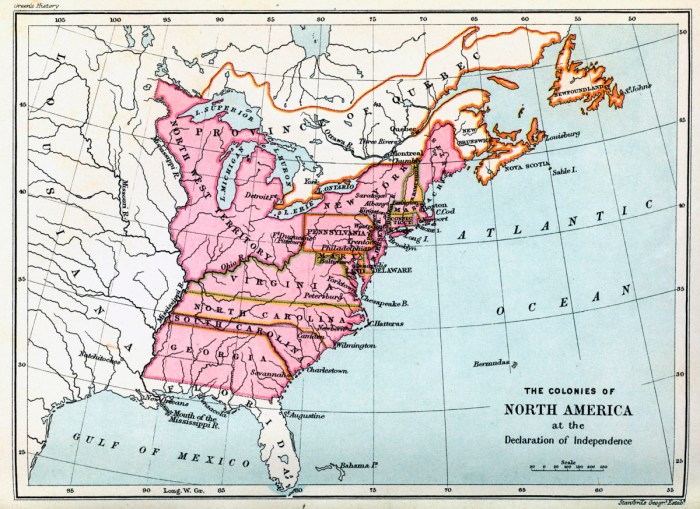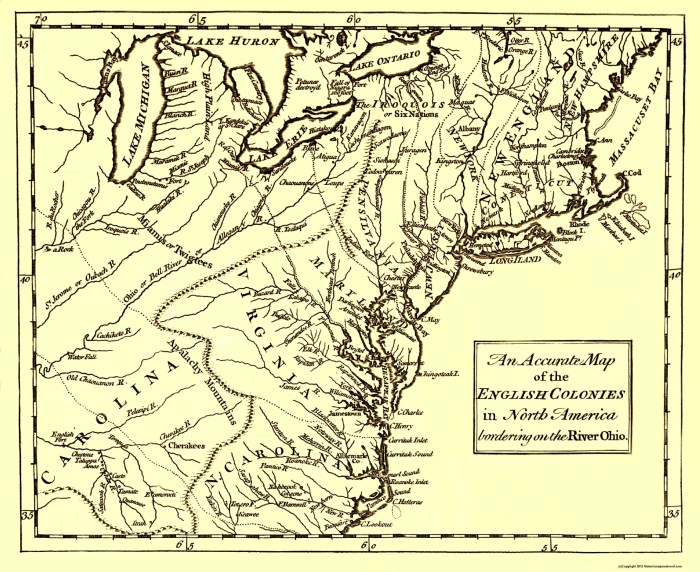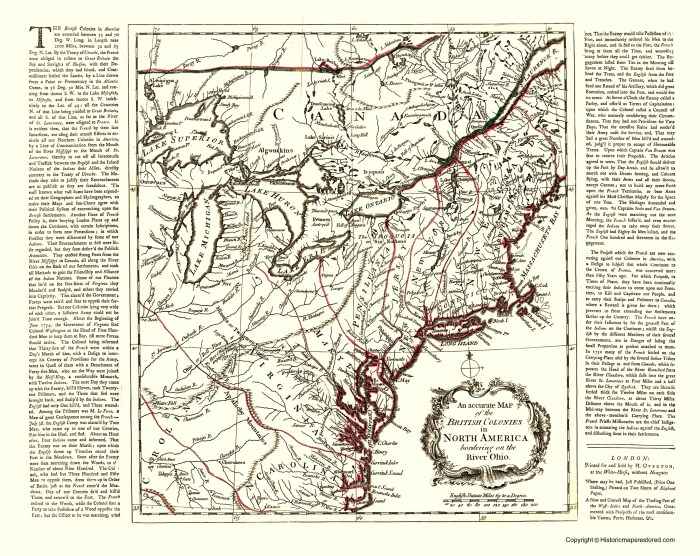Ohio river 13 colonies map – The Ohio River, a crucial waterway for exploration and settlement, played a pivotal role in the westward expansion of the United States. Join us as we delve into the historical significance, geography, economic impact, environmental significance, and cultural heritage of the Ohio River.
Flowing through the heart of the 13 colonies, the Ohio River served as a vital transportation route for goods and people, fostering economic growth and westward expansion.
Historical Significance of the Ohio River

The Ohio River holds immense historical significance as a crucial waterway that shaped the exploration, settlement, and westward expansion of the United States.
In the 17th and 18th centuries, the Ohio River served as a primary transportation route for European explorers and fur traders. French explorers like René-Robert Cavelier, Sieur de La Salle, and Pierre Le Moyne d’Iberville traveled down the river, establishing trading posts and claiming the region for France.
British traders and settlers also ventured into the Ohio Valley, leading to conflicts with Native American tribes.
The Ohio River Valley as a Battleground
The Ohio River Valley became a contested territory during the French and Indian War (1754-1763), with both France and Great Britain vying for control. The British ultimately gained dominance after the war, securing the Ohio Valley for settlement.
During the American Revolutionary War (1775-1783), the Ohio River played a strategic role in the western theater of operations. George Rogers Clark’s expedition down the river in 1778-1779 captured several British forts, securing the Northwest Territory for the newly formed United States.
Gateway to the West
After the Revolution, the Ohio River became a vital artery for westward expansion. Settlers from the eastern states traveled down the river to establish new communities in Kentucky, Ohio, Indiana, and Illinois. The river provided a convenient means of transporting goods and supplies to these frontier settlements.
The Ohio River also played a role in the development of the steamboat. In 1811, the steamboat “New Orleans” made its maiden voyage down the river, revolutionizing transportation and trade in the region.
Geography of the Ohio River

The Ohio River, a prominent tributary of the Mississippi River, plays a vital role in the geography of the Midwestern United States. Spanning a length of approximately 981 miles (1,579 kilometers), it ranks among the largest rivers in the country.
The width of the Ohio River varies, ranging from a narrow 1,000 feet (305 meters) to an impressive 4,000 feet (1,219 meters) at its widest points. The river’s depth also exhibits significant variation, with shallow areas measuring around 2 feet (0.6 meters) and deeper sections reaching up to 100 feet (30.5 meters) or more.The
Ohio River originates at the confluence of the Allegheny and Monongahela Rivers in Pittsburgh, Pennsylvania. From its source, it flows in a generally southwesterly direction, forming the border between Ohio and West Virginia, Kentucky and Indiana, and Illinois and Kentucky.
The river’s course then turns west, separating Kentucky from Missouri and finally emptying into the Mississippi River at Cairo, Illinois.Along its journey, the Ohio River receives water from numerous tributaries, including the Muskingum River, Scioto River, Miami River, Wabash River, and Tennessee River.
These tributaries contribute significantly to the Ohio River’s flow and drainage basin, which encompasses an area of approximately 204,000 square miles (528,000 square kilometers). The Ohio River’s drainage basin covers parts of 14 states, including Pennsylvania, West Virginia, Ohio, Kentucky, Indiana, Illinois, Tennessee, Alabama, Georgia, North Carolina, South Carolina, Virginia, Maryland, and New York.
The Ohio River played a crucial role in the development of the 13 colonies. Its navigable waters provided a vital transportation route, connecting the interior of the country to the Atlantic coast. Interestingly, the ancient Chinese concept of the Lo Shu magic square, which is described in this article , bears striking similarities to the layout of the Ohio River and its tributaries, suggesting a possible connection between ancient Chinese wisdom and the shaping of American geography.
Economic Impact of the Ohio River

The Ohio River has played a significant role in the economic development of the United States. Since its discovery, the river has been a vital transportation route for goods and people, and its fertile lands have supported agriculture and industry.
One of the most important economic activities along the Ohio River has been agriculture. The river’s floodplains are some of the most fertile in the country, and they have been used to grow crops such as corn, soybeans, and wheat for centuries.
In addition, the river’s tributaries provide water for irrigation, which has allowed farmers to expand their operations into drier areas.
The Ohio River has also been a major center for industry. The river’s abundant water supply and access to transportation have made it an ideal location for factories and mills. In the 19th century, the Ohio River Valley was a major center for the iron and steel industry.
Today, the river is home to a variety of industries, including chemicals, plastics, and food processing.
Transportation and Trade, Ohio river 13 colonies map
The Ohio River has been a vital transportation route for centuries. In the early days, the river was used by Native Americans to transport goods and people. In the 18th and 19th centuries, the river was used by settlers to move west.
Today, the river is used to transport a variety of goods, including coal, grain, and chemicals.
The Ohio River is also a major trade route. The river connects the Midwest to the East Coast, and it is used to transport goods between the two regions. The river is also used to transport goods to and from Canada.
Environmental Significance of the Ohio River: Ohio River 13 Colonies Map

The Ohio River plays a crucial role in sustaining a diverse ecosystem, supporting a wide range of plant and animal life. However, the river faces numerous environmental challenges and threats.
Challenges and Threats
The Ohio River’s ecosystem is impacted by pollution from industrial sources, agricultural runoff, and sewage discharge. These contaminants can harm aquatic life, degrade water quality, and affect human health.
Additionally, habitat loss and fragmentation due to development, dams, and other human activities pose significant threats to native species.
Conservation Efforts
Efforts are underway to protect and restore the Ohio River’s ecosystem. These include:
- Enforcing regulations to control pollution and improve water quality.
- Protecting and restoring riparian habitats to support native species.
- Educating the public about the importance of the river and promoting responsible stewardship.
Cultural Heritage of the Ohio River

The Ohio River holds a deep cultural significance, shaping the identity and traditions of the region it flows through. Its banks have witnessed centuries of human history, leaving behind a rich tapestry of folklore, music, and cultural practices.
The river has served as a vital artery for transportation, trade, and communication, fostering a sense of community and shared experiences among the people living along its shores. Its waters have inspired countless stories, songs, and legends that have been passed down through generations.
Folklore and Legends
The Ohio River is steeped in folklore and legends, reflecting the diverse cultures that have interacted with its waters. Native American tribes have long held the river sacred, believing it to possess spiritual powers and to be a conduit to the afterlife.
- One popular legend tells the tale of a giant catfish that inhabits the river, a symbol of its strength and mystery.
- Another legend speaks of a lost city beneath the river’s surface, a place of untold riches and secrets.
Music and Arts
The Ohio River has played a significant role in the development of American music and arts. Its banks have nurtured a vibrant music scene, with genres ranging from bluegrass and folk to rock and blues.
- The river has inspired countless songs, including “The Ohio River Song” by Johnny Cash and “Down by the Ohio” by Bruce Springsteen.
- Artists have also found inspiration in the river’s beauty and history, creating paintings, sculptures, and other works of art that celebrate its significance.
Cultural Events and Festivals
The cultural heritage of the Ohio River is celebrated through various events and festivals held throughout the region.
- The Ohio River Sternwheel Festival in Marietta, Ohio, features riverboat races, live music, and historical reenactments.
- The Kentucky Bourbon Trail Tour allows visitors to explore the state’s distilleries and sample its famous bourbon whiskey, a product closely associated with the Ohio River region.
FAQs
What was the Ohio River’s role in westward expansion?
As a major waterway, the Ohio River provided a vital transportation route for settlers and goods, facilitating the westward expansion of the United States.
How long is the Ohio River?
The Ohio River stretches approximately 981 miles from its source at the confluence of the Allegheny and Monongahela rivers to its confluence with the Mississippi River.
What are some of the major tributaries of the Ohio River?
The Ohio River receives water from numerous tributaries, including the Tennessee River, Cumberland River, and Wabash River.


